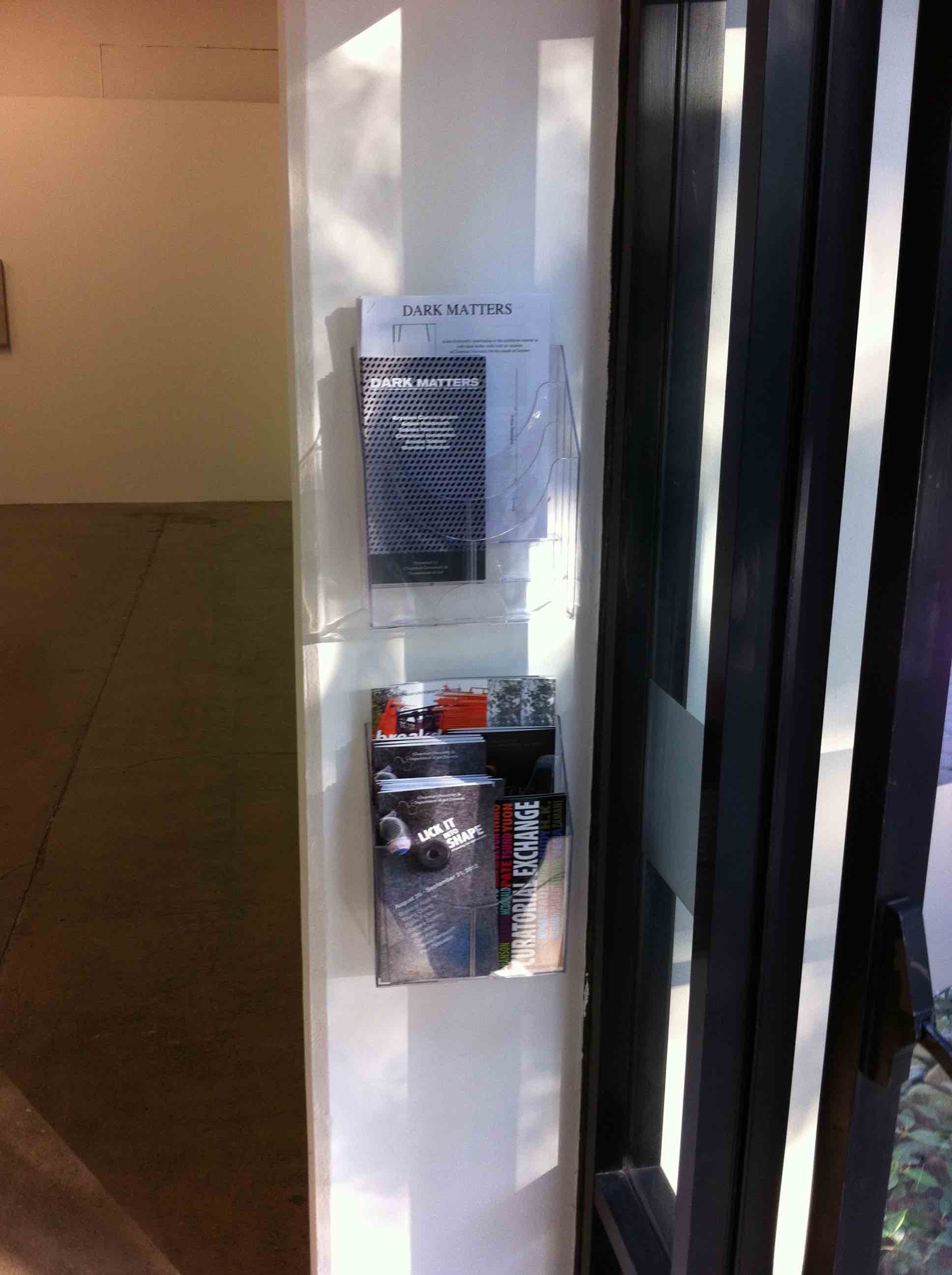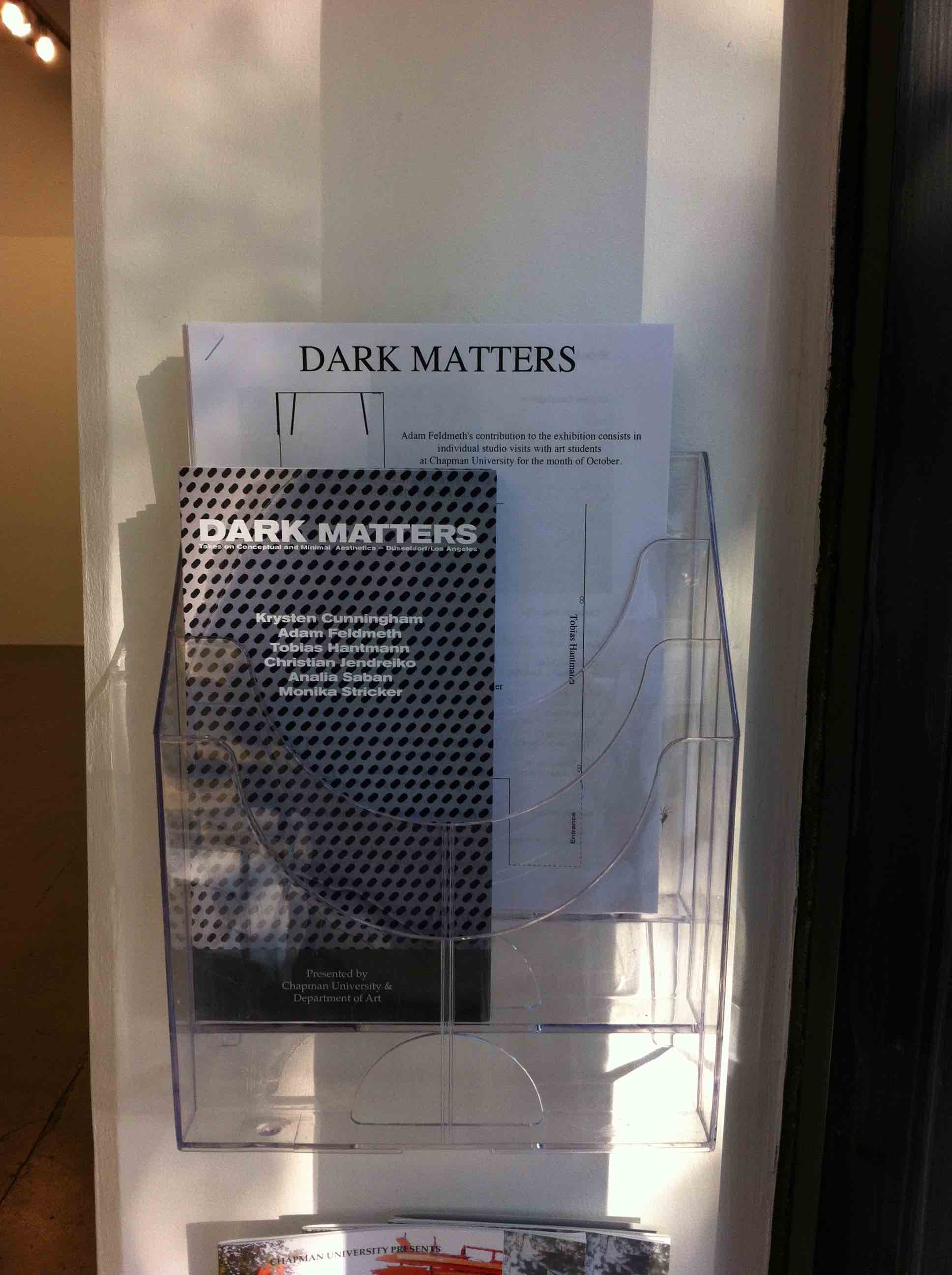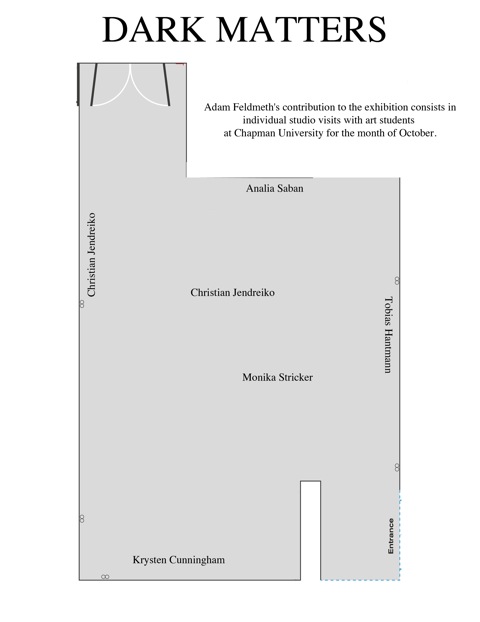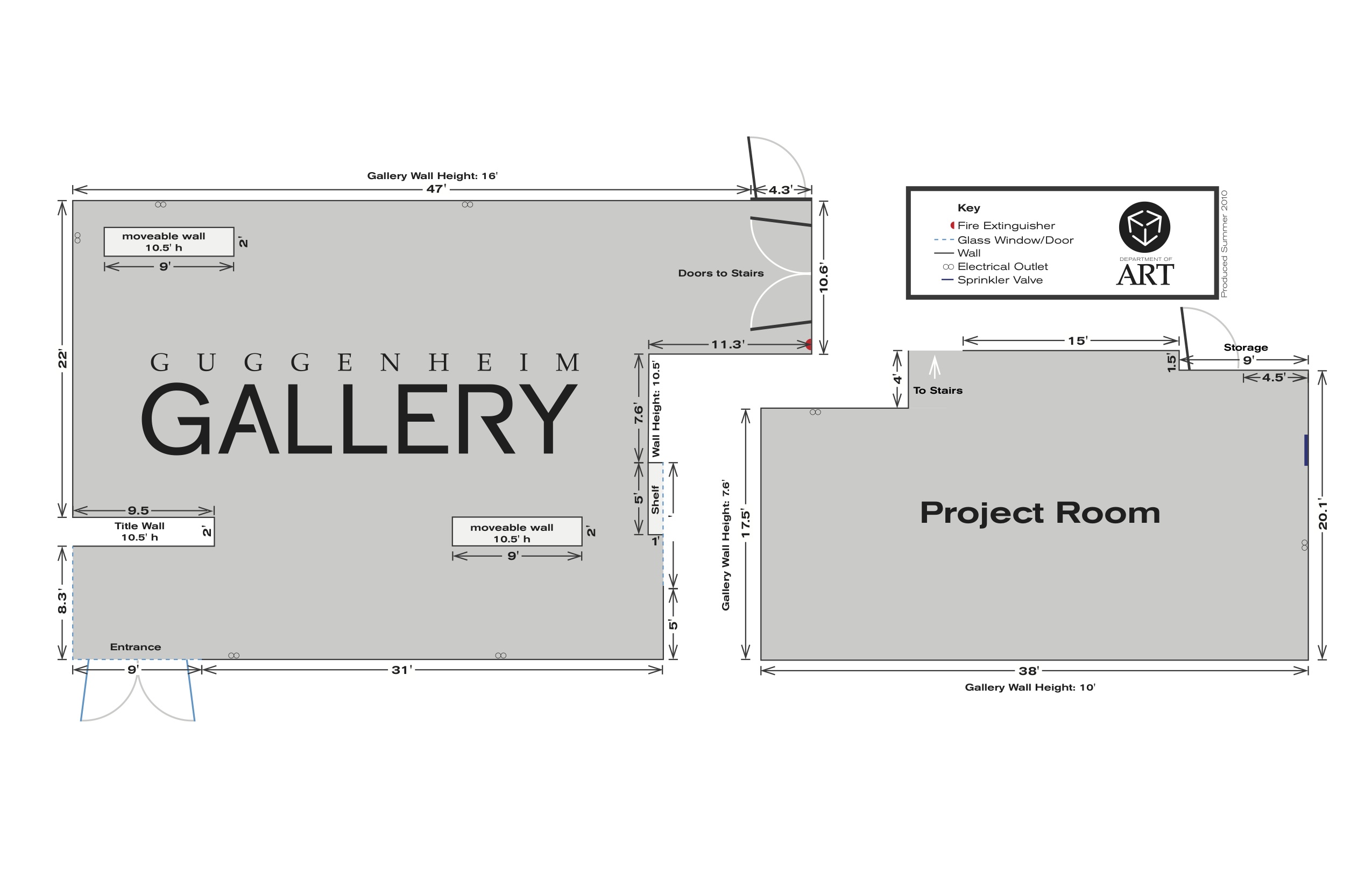
In early fall 2012, I was invited to participate in an exhibition being organized by Marcus Herse, curatorial director of the Guggenheim Gallery located at Chapman University in Orange, California entitled, Dark Matters: Takes on Minimal and Conceptual Aesthetics - Düsseldorf/Los Angeles. The notice came with very little time to develop a project. After a site visit to the academic campus and gallery and researching the history of the Art Department, the architecturally connected Guggenheim Gallery, and the university as diligently as I could, I submitted a proposal which was immediately accepted.

Copies of a trifold brochure, published with the exhibition, were in a two-pocket tiered acrylic brochure holder, available on a narrow section of wall directly to the right of the entrance doors to the gallery space. Additionally, copies of an exhibition map and a title list for the Dark Matters show, stapled together, were also found, in the second tier, of this acrylic holder. These items are used for contextual and situational use inside the room as well as free take-away. The documents were standard to the curated exhibitions at the Guggenheim Gallery at the time of the exhibition. An identical holder is mounted below this one holding the brochures from recent past exhibitions. While this brochure holder and its contents were not a unique presence to this show as forms, they led toward a partial framing of my participation.
The trifold brochure contains specific information regarding the exhibition including all information identical to that in the emailed press release, consisting of the introductory curatorial press text/statement, artist biographies, and accompanying single images provided by each participant.

I declined to provide an image; only my written bio appears in the press release and in this brochure. My biography read:
"Adam Feldmeth's work often only exists within the process of (a) discussion. He enacts investigations with his contemporaries into their own practices, questioning the supplemental details of a context, be it in an object, a site or an idea. His thoroughness and durational investment in the practices of others attempts to critically expose the latent autonomy of the artist as idea-maker. Through breadth and analysis he emphasizes the internal discursiveness of an artistic process. Currently, he maintains regular appointments with students in the art programs at the California Institute of the Arts and the University of California Los Angeles as well as with art professionals in Los Angeles, Berlin and elsewhere. He has recently contributed to exhibitions at TAET, Berlin; Overgaden Institute for Contemporary Art Copenhagen; and JB Jurve, Los Angeles. His investigation and subsequent consultation in a reconstructed Blinky Palermo installation at the 53rd Venice Biennale appeared as a featured article in X-TRA Contemporary Art Quarterly in autumn, 2011."
Also printed in this brochure, on the back side, are two statements authored by the Chapman Art Department in a university approaved, copy-edit language, which were standard to all Guggenheim Gallery exhibition brochures:
"Department of Art Mission Statement: The Mission of the Department of Art at Chapman University is to offer a comprehensive education that develops the technical, perceptual, theoretical, historical and critical expertise needed for successful careers in visual art, graphic design and art history. The department supports artists, designers, and scholars within a rigorous liberal arts environment that enriches the human mind and spirit. We foster the artistic and academic growth necessary to encourage lifelong study and practice of the arts through a curriculum that contains strong foundation and history components as a basis for continued innovations in contemporary practice and scholarship.
Guggenheim Gallery Mission Statement: The department of art will provide provocative exhibitions and educational programming that provide a local connection to the national and international dialogue about contemporary art and provide a framework for an interchange between artists, scholars, students and the community at large. While the exhibitions feature contemporary art, they often address other disciplines and societal issues in general. Integrated into the curriculum, these programs contribute significantly to the Chapman education."
These statements, the gallery mission statement in particular, were specific in the development of my proposal.

The exhibition map outlines the artist names, written in the general location of the room, where each artwork is installed and/or is to be found. After seeing this map from a previous exhibition during a site visit in a meeting with the curator, I asked about this choice of demarcating artwork locations through the printed names of the artists.
I had seen this layout utilized in other exhibitions; it is by no means uncommon. We subsequently discussed the different ways to facilitate this kind of visual guide, bridging physical site and content within it.
A comparative option was posed in this discussion was to give each artist (or artwork for that matter) a corresponding numeral on the map. A curatorial choice of providing the artist's name in place of the general placement of an artwork seemed a peculiar compression. It descriptively suggests how one can find the artwork via an artist's name printed in this corner or along this wall face on a map like this. Perhaps it emphasizes the possibility that we can also find the artist in the object at the corresponding location? Would anyone confuse these names in the floor plan of the room as though the artists would be standing in the corner or along the wall? As it happened, the curator did not place my name inside the lines of this schematic of the gallery. My name was compositionally outside the grey interior expanse of the gallery. Does being on the page but not in the drawn limits of the gallery still imply I am on the map? Curiously, it was not just my name in print, like all other named participants included on the map; my name was bound to the description of my contribution. The sentence was excerpted by the curator from my submitted proposal:
"Adam Feldmeth's contribution to the exhibition consists in individual studio visits with art students at Chapman University for the month of October."
Two subsequent pages stapled to this map listed all didactic information: titles, materials, and dimensions for all exhibition artworks. This sentence acknowledging my contribution was printed a second time in this works list. This doubling situates a redundancy of the statement placed in both the area proximal to the gallery interior on the map as well as the list of material artworks found within it.
The description of my contribution and my name on the page carrying the map are bound together whereas all other names are independent, only names within the limits of the gallery. After visiting the opening and seeing this curatorial decision, I subsequently inquired why my name appeared bound to the work. The response was that my name had been connected to deter confusion for a visitor when utilizing the map in the room and upon correlating all names thereon/in with identifiable artworks (physical objects). In other words, seeking my [physical] place would be perplexing if my name were printed in the unmapped area of the page, let alone placed in the physical gallery interior.
Because there was no primary physical object-cum-artwork provided by me in the room became the rationale for placing my name outside the room's diagramatic limits. Where would the name "Adam Feldmeth" be placed with no corollary material artwork? Yet, if a visitor is using this map in the show, then this person also will search for specific information for each work in the list of works on the subsequent stapled pages. Here is an instance in which the topics addressed in the introductory curatorial statement are at odds with the presence of the exhibition, which is largely a physical and material one. Though following these axioms, the physical and material placeholders of my process did have location within the room, notably, in the entrance area: 1) my name in vinyl along with the other artists' names and the show title on the "title wall", parallel to the entrance doors, 2) the brochure with my biography designed specifically as a component to my proposal, the introductory text and mission statements, et al., and 3) the map and works list pages. All three, circumstantially, are wall mounted supplements within the room. All three points contain my name in print. It could have been a completely logical option to have printed my name on the map within the limits of the room, placed by the entrance area where these supplements are located as these supplements become the primary access point to my contribution. That my name is printed outside of the room, and tied to a proposition, inadvertently indexes much more of the circumstances not only of my contribution and its relative place(ment) as part of the show; it also raises questions on what is found in the room and what is not found, comparative to the curatorial premise and primary exhibition title.

In an official floor plan of the Guggenheim Gallery not publicly available, a "Project Room" is pictured in addition to the main gallery room where the exhibition occurred. This space subsequently became an integral part of my placement in the show as an unmapped contributor. The Project Room is a room located on the second floor of the Guggenheim Gallery, adjacent to the south wall of the main room though at the time in no way apparent as existing to those unfamiliar with the architecture. One can enter this annex space by a stairway located in a hallway currently used for pedestal storage accessed through the passage marked "doors to stairs" on the official schematic. These doors remain closed during exhibitions though not locked during general hours. In the past, this project room was an auxiliary exhibition space for shows, but in the beginning of this academic year, as I learned through my research, had been reprioritized. The department of art had fully absorbed the space, re-designating it a critique room. The repurposing is why this former annex to the main gallery space was not included on the exhibition map in the Dark Matters show. I came to learn that the reason for this change was due to the department assessing a need for a space to discuss student artwork and projects which was flexibly available for any and all courses. Conveniently, the room has the attributes of an exhibition space because it was designed to be one. It is all to common in art education that collapses occur between spaces of discursive learning and those aligned for display.
Interconnected to this, the educational context of Chapman University provides only one student exhibition space, the Guggenheim Gallery. During the academic year, this space is shared between curated exhibitions and student shows. The art department had effectively taken away square footage of the Guggenheim Gallery space once used for curated exhibitions under the re-designation of this project room on the second floor as an annex classroom space for discourse, folding it back into the day-to-day educational context. Does this previous Project Room become more of a classroom now? In what ways? The concrete floor, the white walls, the track lighting is all still there. The availability to projectors, dvd players and other technology is shared with the artwork needs in the Guggenheim Gallery. To what extent was the Project Room, when labeled a secondary gallery space, and the big room below, a component to a student's education as promised in the mission statements? With the change in use, the room had broken from the timeline(s) of the exhibitions in the Guggenheim Gallery. Whereas before, this annex was bound to the monthly rotation of exhibitions below, now the duration of which something is installed therein seems to be predicated upon the critical discussion intended to occur in relation to it.
The altered use of this Project Room is significant for two reasons:
1) The place on the map where my name is printed is in the same area as this now excised and unacknowledged former Project Room. The doors leading to the stairs in the official schematic are still rendered in the Dark Matters map, perhaps leading someone to think that to go through these doors would lead to the location of my work in the exhibition.
2) The description of my proposal uses the wording "individual studio visits". The reality for art students at this university is that there are no individual studio spaces for them on campus. There are shared production spaces like a wood and metal laboratory, which are open during daytime hours as classroom space. However, no private studio space, solo or shared, is available to them through the program. This detail factored in during the development of the proposal. I considered the use of the term “studio visit” in the statement in an open colloquial form: to visit the artist, their work, their ideas, wherever physically that may be, or with laptop, or however. Albeit one exception, for all the meetings I had with students, I met each individual to explore questions of projects and praxis in this Project Room by their request. (The one exception took place in the sculpture lab/woodshop.) Some students made a temporary installation of artworks in the Project Room and others more casually laid things out on the floor as if the interest to share came without compulsion and/or want to display.
In having the majority of the visits take place in this newly designated critical, curricular room, the question raised to the curator as to whether a person might confuse the printed names on the map for the place to locate that artist became an actuality in my case. If one interpreted the map literally, in terms of name placements, one could have potentially found me in this unmarked, former annex to the exhibition. Through corresponding to temporal realignments of this space due to the new curricular usage, my presence was not constant in the way the other contributions to the show were, i.e. I was not in this room constantly or daily for the weeks of the exhibition. I was conscious of its recently assigned flexible application time-wise, then recently disjointed from those of the Guggenheim Gallery brought about by standardized timelines of exhibitions. I was unaware if during the time of the exhibition this room was used on days and times I was not visiting with students. I am also not currently clear if it is retained as an auxiliary display space during student exhibitions.
Another important component that helped structure the proposal is that these students, through the regular educational allotment, have very little contact with artists and thinkers outside of their faculty responding to their work. This may in part be predicated on the distance of Chapman University from Los Angeles, some thirty miles. Available funding coupled with university and departmental requirements and budgets also had compounded the possibility for such exchange. I learned from the curator who also was teaching a course in “Contemporary Gallery Practices” that the students generally had no opportunities to have critique, observations and/or discussion with their work outside of class and meetings with their professors and peers. Outside art producers visiting students and their work were not a component of the curriculum. There does exist an annual calendar of artist lectures; however, in these occasions, the artist and student are in a room with established division brought on by lecturer and audience member separation. The artist lecturers do not do studio visits with students in addition to these formal talks. And most distinctly, the work being introduced and considered is that of the visiting artist's, not the student's own. These factors situated my contribution to the curricular structure promised in the mission statements: extra-curricular without being external to the curricular scope, inclusive to the Guggenheim Gallery's purpose and mission accompanying and within the educational context.